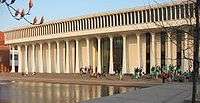Minoru Yamasaki
Minoru Yamasaki (山崎 實, Yamasaki Minoru, 1 December 1913 – 6 February 1986)[1][2][3] was a Japanese-American architect, best known for designing the original World Trade Center in New York City and several other large-scale projects.[4] Yamasaki was one of the most prominent architects of the 20th century. He and fellow architect Edward Durell Stone are generally considered to be the two master practitioners of "New Formalism".[5][6]
Minoru Yamasaki | |
|---|---|
山崎 實 | |
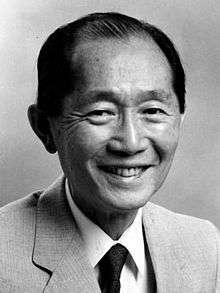 | |
| Born | December 1, 1912 Seattle, Washington, U.S. |
| Died | February 6, 1986 (aged 73) |
| Nationality | American |
| Alma mater | University of Washington, New York University |
| Occupation | Architect |
| Spouse(s) |
|
| Children | Carol, Taro, Kim |
| Buildings | |
| Projects | Pruitt–Igoe |
| Design | Inspiration by Gothic architecture and usage of narrow vertical windows |
Early life and education
Yamasaki was born in Seattle, Washington, the son of John Tsunejiro Yamasaki and Hana Yamasaki, issei Japanese immigrants.[7][4] The family later moved to Auburn, Washington and he graduated from Garfield Senior High School in Seattle. He enrolled in the University of Washington program in architecture in 1929, and graduated with a Bachelor of Architecture (B.Arch.) in 1934.[8] During his college years, he was strongly encouraged by faculty member Lionel Pries. He earned money to pay for his tuition by working at an Alaskan salmon cannery,[9] working five summers and earning $50 a month, plus 25 cents an hour in overtime pay.[10]
In part to escape anti-Japanese prejudice, he moved to Manhattan in 1934, with $40 and no prospects.[11] He wrapped dishes for an importing company until he found work as a draftsman and engineer.[12] After moving to New York City in the 1930s, he enrolled at New York University for a master's degree in architecture and got a job with the architecture firm Shreve, Lamb & Harmon, designers of the Empire State Building. In 1945, Yamasaki moved to Detroit, where he was hired by Smith, Hinchman & Grylls.[13] The firm helped Yamasaki avoid internment as a Japanese-American during World War II, and he himself sheltered his parents in New York City.[7][14] Yamasaki left the firm in 1949, and started his own partnership.[13] He worked out of Birmingham and Troy, Michigan. One of the first projects he designed at his own firm was Ruhl's Bakery at 7 Mile Road and Monica Street in Detroit.[15] In 1964, Yamasaki received a D.F.A. from Bates College.
His firm, Yamasaki & Associates, closed on December 31, 2009.[16]
Career
His first internationally recognized design, the Pacific Science Center with its iconic arches, was constructed by the City of Seattle for the 1962 Seattle World's Fair.[7] His first significant project was the Pruitt–Igoe housing project in St. Louis in 1955. Despite his love of traditional Japanese design and ornamentation, this was a stark, modernist concrete structure. The housing project experienced so many problems that it was demolished in 1972, less than twenty years after its completion. Its destruction is considered by architecture historian Charles Jencks to be the end of modernist architecture.[4]
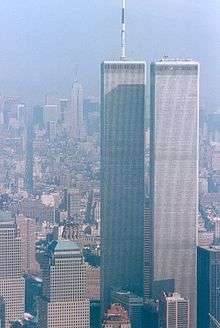
In 1955, he also designed the "sleek" terminal at Lambert–St. Louis International Airport which led to his 1959 commission to design the Dhahran International Airport in Saudi Arabia. In the 1950s, Yamasaki was commissioned by the Reynolds Company to design an aluminum-wrapped building in Southfield, Michigan, which would "symbolize the auto industry's past and future progress with aluminum."[17] The three-story glass building wrapped in aluminum, known as the Reynolds Metals Company's Great Lakes Sales Headquarters Building, was also supposed to reinforce the company's main product and showcase its admirable characteristics of strength and beauty.[18] During this period, he created a number of office buildings which led to his innovative design of the 1,360 ft (410 m) towers of the World Trade Center in 1964, which began construction March 21, 1966.[19] The first of the towers was finished in 1970.[20] Many of his buildings feature superficial details inspired by the pointed arches of Gothic architecture, and make use of extremely narrow vertical windows. This narrow-windowed style arose from his own personal fear of heights.[21] One particular design challenge of the World Trade Center's design related to the efficacy of the elevator system, which was unique in the world. Yamasaki integrated the fastest elevators at the time, running at 1,700 feet per minute. Instead of placing a large traditional elevator shaft in the core of each tower, Yamasaki created the Twin Towers' "Skylobby" system. The Skylobby design created three separate, connected elevator systems which would serve different segments of the building, depending on which floor was chosen, saving approximately 70% of the space used for a traditional shaft. The space saved was then used for office space.[22]
In 1978, Yamasaki designed the Federal Reserve Bank tower in Richmond, Virginia. The work was designed with a similar appearance as the World Trade Center complex, with its narrow fenestration, and now stands at 394 ft (120 m).[23][24]
Yamasaki was a member of the Pennsylvania Avenue Commission, created in 1961 to restore the grand avenue in Washington, D.C., but resigned after disagreements and disillusionment with the design by committee approach.[25]
After partnering with Emery Roth and Sons on the design of the World Trade Center, they collaborated on other projects including new buildings at Bolling Air Force Base in Washington, D.C.[26]
The campus for the University of Regina was designed in tandem with Yamasaki's plan for Wascana Centre, a park built around Wascana Lake in Regina, Saskatchewan. The original campus design was approved in 1962. Yamasaki was awarded contracts to design the first three buildings: the Classroom Building; the Laboratory Building; and the Dr. John Archer Library, which were built between 1963 and 1967.[27]
Yamasaki designed two notable synagogues during this period, North Shore Congregation Israel in Glencoe, Illinois in 1964 and Temple Beth El, in Bloomfield Hills, Michigan in 1973. He designed a number of buildings on the campus of Carleton College in Northfield, Minnesota between 1958 and 1968.[28]
Personal life
Yamasaki was first married in 1941 to Teruko "Teri" Hirashiki. They had three children together: Carol, Taro, and Kim.[29] They divorced in 1961 and Yamasaki married Peggy Watty. Him and Watty divorced two years later, and Yamasaki would marry a third time briefly before remarrying Teruko in 1969. In a 1969 Detroit News article about the remarriage, Yamasaki said "I'm just going to be nicer to her".[30] Minoru Yamasaki died of stomach cancer when he was 73.[6][31]
Mr. Yamasaki was survived by his wife; two sons, Kim and Taro, the latter of whom won a Pulitzer Prize while a photographer for The Detroit Free Press; a daughter, Carol Yamasaki Chakrin; a brother, and eight grandchildren.[32]
Gallery
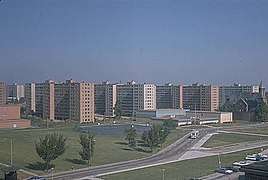 The former Pruitt–Igoe housing project, St. Louis, 1954 (demolished 1972–1976)
The former Pruitt–Igoe housing project, St. Louis, 1954 (demolished 1972–1976)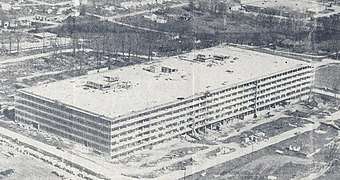 The Military Personnel Records Center, St. Louis, 1955
The Military Personnel Records Center, St. Louis, 1955 Pacific Science Center, Seattle, 1962
Pacific Science Center, Seattle, 1962- One Woodward Avenue, Detroit, 1962
 Irwin Library at Butler University, Indianapolis, 1963
Irwin Library at Butler University, Indianapolis, 1963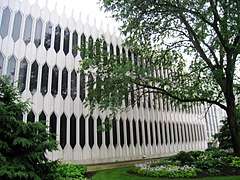
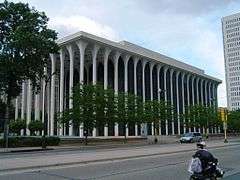
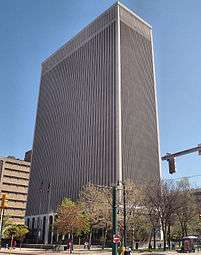 One M&T Plaza, Buffalo, New York, 1966
One M&T Plaza, Buffalo, New York, 1966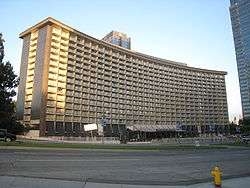 Century Plaza Hotel, Los Angeles, California, 1966
Century Plaza Hotel, Los Angeles, California, 1966.jpg) The original World Trade Center, 1970–1971 (destroyed in 2001)
The original World Trade Center, 1970–1971 (destroyed in 2001) Horace Mann Educators Corporation, Springfield Illinois, 1972[33]
Horace Mann Educators Corporation, Springfield Illinois, 1972[33] Temple Beth El, Bloomfield Township, Michigan, 1973
Temple Beth El, Bloomfield Township, Michigan, 1973 Century Plaza Towers, Los Angeles, 1975
Century Plaza Towers, Los Angeles, 1975
 Rainier Tower, Seattle, 1977
Rainier Tower, Seattle, 1977 Federal Reserve Bank, Richmond, 1978
Federal Reserve Bank, Richmond, 1978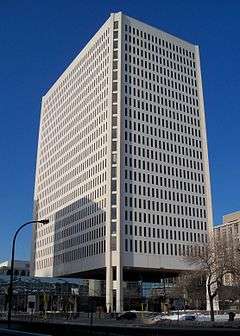 100 Washington Square, Minneapolis, 1982
100 Washington Square, Minneapolis, 1982_10.jpg) Torre Picasso, Madrid, 1988
Torre Picasso, Madrid, 1988
Honors and legacy
- Yamasaki was elected as a Fellow of the American Institute of Architects in 1960.
- Yamasaki won the American Institute of Architects' First Honor Award three times.[8]
- Featured as the cover story of TIME on 18 January 1963.[34]
- Researchers can access archival evidence of Yamasaki's work in The papers of Minoru Yamasaki at the Walter P. Reuther Library. Available materials include correspondence on projects, travel, communications with associates, speaking invitations, and involvement in professional organizations. Early architectural drawings, speeches and writings, photographs, awards and doctoral degrees, scrapbooks detailing the progress of his career, and various publications are also included.
Notes
- Rimer, Sara (February 9, 1986). "Minoru Yamasaki, Architect of World Transit Center, Dies". The New York Times. Retrieved November 22, 2016.
- Murphy, Dean (February 9, 1986). "Architect Minoru Yamasaki Dies at 73: Designs Include Century Plaza Towers, N.Y. World Trade Center". The Los Angeles Times. Retrieved November 22, 2016.
- "World Trade Center architect's grave". Flickr. Retrieved 2018-07-01.
- Davidson, Justin (August 27, 2011). "The Encyclopedia of 9/11: Yamasaki, Minoru: An architect whose legacy didn't work out as he'd planned". New York.
- "Architecture and Design of the Music Center". Performing Arts Center of Los Angeles County. Archived from the original on October 11, 2014. Retrieved March 30, 2011.; excerpting from HABS documentation: "Los Angeles Music Center". Historic American Buildings Survey.
- "World Trade Center architect Minoru Yamasaki wanted 'living symbol' for humanity". Federal Way Mirror. 2011-09-08. Retrieved 2020-08-12.
- Crowley, Walt (3 March 2003). "Yamasaki, Minoru (1912-1986), Seattle-born architect of New York's World Trade Center". HistoryLink.org. Retrieved 2012-11-17.
- Esterow, Milton (21 September 1962). "Architect Named for Trade Center". The New York Times.
- "Center Will Reflect Architectural Collaboration". The New York Times. January 19, 1964.
- "Minoru Yamasaki, architect of World Trade Center Dies". New York Times. February 9, 1986. Retrieved 2020-07-15.
- "Minoru Yamasaki, architect of World Trade Center Dies". New York Times. February 9, 1986. Retrieved 2020-07-15.
- "Minoru Yamasaki, architect of World Trade Center Dies". New York Times. February 9, 1986. Retrieved 2020-07-15.
- Huxtable, Ada Louise (November 25, 1962). "Pools, Domes, Yamasaki - Debate". The New York Times.
- "Minoru Yamasaki 1912-". encyclopedia.com. Retrieved 2012-03-15.
- Interview with owner's daughter. Original architectural drawings donated to the University of Michigan.
- Gallagher, John (28 January 2010). "A Once Eminent Firm Meets a Bitter End". Architectural Record. Retrieved 2012-11-17.
- "Reynolds Review". Reynolds Review (company magazine). Reynolds Metals Papers, Virginia Historical Society. 1959.
- Ong Yan, Grace (2012). "Wrapping Aluminum at the Reynolds Metals Company". Design and Culture. 4 (3): 299–323. doi:10.2752/175470812X13361292229113.
- Remarks by the Hon. Richard J. Hughes, World Trade Center Press Conference, New York Hilton Hotel, January 18, 1964.
- "History of the Twin Towers". Port Authority of New York and New Jersey. Retrieved 2014-12-12.
- James, Glanz; Lipton, Eric (2003). City in the sky: the rise and fall of the World Trade Center. Macmillan. p. 109. ISBN 978-0-8050-7428-4.CS1 maint: ref=harv (link)
- Remarks by Lee K. Jaffee, World Trade Center Press Conference, New York Hilton Hotel, January 18, 1964.
- "Federal Reserve Bank Building, Richmond". Emporis. Retrieved 2018-09-11.
- "Federal Reserve Bank". Architecture Richmond. Retrieved 2018-09-11.
- Huxtable, Ada Louise (2 February 1964). "N.Y.C. Architectural Ups and Downs". The New York Times.
- Robbins, William (26 March 1967). "2 Firms Are Welding Abilities to Plan World Trade Center". The New York Times. Retrieved 2012-11-17.
- Riddell, William A. The First Decade, 1960-1970. Regina: University of Regina, 1974. pp.91-95.
- "Why is my Dorm so Ugly?". Carleton College. 24 February 2009. Retrieved 2012-11-17.
- Walt Crowley (March 3, 2003). "Yamasaki, Minoru (1912-1986)". www.historylink.org. Retrieved 2020-08-12.
- "Minoru Yamasaki, world-class architect". The Detroit News. August 14, 1998. Retrieved 2019-09-18.
- "Minoru Yamasaki, architect of World Trade Center Dies". New York Times. February 9, 1986. Retrieved 2020-07-15.
- "Minoru Yamasaki, architect of World Trade Center Dies". New York Times. February 9, 1986. Retrieved 2020-07-15.
- "Horace Mann corporate headquarters doubles as architectural landmark". The State Journal-Register. Springfield, Illinois. 5 September 2015. Retrieved 2 February 2017.
- "Art: The Road to Xanadu". Time. LXXXI (3): cover. 18 Jan 1963.
References
- Yamasaki, Minoru (1979). A Life in Architecture. New York: Weatherhill. ISBN 978-0-8348-0136-3.
- Nobel, Philip (2005). Sixteen Acres: The rebuilding of the World Trade Center site. London: Granta. ISBN 978-1-8620-7713-3.
External links
| Wikimedia Commons has media related to Minoru Yamasaki. |
- GreatBuildings.com listing
- The Wayne State University Yamasaki Legacy
- Minoru Yamasaki interview, [ca. 1959 Aug.] - Archives of American Art
- Hadley, Jane (September 13, 2001), "Seattle architect created trade center as peace symbol", The Seattle Post-Intelligencer
- Images from the Minoru Yamasaki Collection Walter P. Reuther Library

